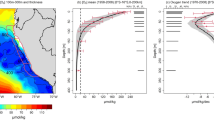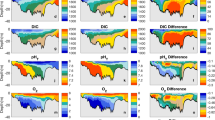Abstract
Human inputs of nutrients to coastal waters can lead to the excessive production of algae, a process known as eutrophication. Microbial consumption of this organic matter lowers oxygen levels in the water1,2,3. In addition, the carbon dioxide produced during microbial respiration increases acidity. The dissolution of atmospheric carbon dioxide in ocean waters also raises acidity, a process known as ocean acidification. Here, we assess the combined impact of eutrophication and ocean acidification on acidity in the coastal ocean, using data collected in the northern Gulf of Mexico and the East China Sea—two regions heavily influenced by nutrient–laden rivers. We show that eutrophication in these waters is associated with the development of hypoxia and the acidification of subsurface waters, as expected. Model simulations, using data collected from the northern Gulf of Mexico, however, suggest that the drop in pH since pre-industrial times is greater than that expected from eutrophication and ocean acidification alone. We attribute the additional drop in pH—of 0.05 units—to a reduction in the ability of these carbon dioxide-rich waters to buffer changes in pH. We suggest that eutrophication could increase the susceptibility of coastal waters to ocean acidification.
This is a preview of subscription content, access via your institution
Access options
Subscription info for Japanese customers
We have a dedicated website for our Japanese customers. Please go to natureasia.com to subscribe to this journal.
Buy this article
- Purchase on SpringerLink
- Instant access to full article PDF
Prices may be subject to local taxes which are calculated during checkout




Similar content being viewed by others
References
Diaz, R. J. & Rosenberg, R. Spreading dead zones and consequences for marine ecosystems. Science 321, 926–929 (2008).
Doney, S. C. The growing human footprint on coastal and open-ocean biogeochemistry. Science 328, 1512–1516 (2010).
Gilbert, D., Rabalais, N. N., Díaz, R. J. & Zhang, J. Evidence for greater oxygen decline rates in the coastal ocean than in the open ocean. Biogeosciences 7, 2283–2296 (2010).
Orr, J. C. et al. Anthropogenic ocean acidification over the twenty-first century and its impact on calcifying organisms. Nature 437, 681–686 (2005).
Fabry, V. J., Seibel, B. A., Feely, R. A. & Orr, J. C. Impacts of ocean acidification on marine fauna and ecosystem processes. ICES J. Mar. Sci. 65, 414–432 (2008).
Thomas, H. et al. Rapid decline of the CO2 buffering capacity in the North Sea and implications for the North Atlantic Ocean. Glob. Biogeochem. Cycles 21, GB4001 (2007).
Feely, R. A., Sabine, C. L., Hernandez-Ayon, J. M., Ianson, D. & Hales, B. Evidence for upwelling of corrosive ‘acidified’ water onto the continental shelf. Science 320, 1490–1492 (2008).
Tseng, C. M. et al. Temporal variations in the carbonate system in the upper layer at the SEATS station. Deep-Sea Res II 54, 1448–1468 (2007).
Feely, R. A. et al. The combined effects of ocean acidification, mixing, and respiration on pH and carbonate saturation in an urbanized estuary. Estuar. Coast. Shelf Sci. 88, 442–449 (2010).
Brewer, P. G. A changing ocean seen with clarity. Proc. Natl Acad. Sci. USA 106, 12213–12214 (2009).
Hutchins, D., Mulholland, M. R. & Fu, F. Nutrient cycles and Marine Microbes in a co-enriched ocean. Oceanography 22, 128–145 (2009).
Bianchi, T. S. & Allison, M. A. Large-river delta-front estuaries as natural “recorders” of global environmental change. Proc. Natl Acad. Sci. USA 106, 8085–8092 (2009).
Rabalais, N. et al. Hypoxia in the northern Gulf of Mexico: Does the science support the plan to reduce, mitigate, and control hypoxia? Estuar. Coast. 30, 753–772 (2007).
Raymond, P. A., Oh, N-H., Turner, R. E. & Broussard, W. Anthropogenically enhanced fluxes of water and carbon from the Mississippi River. Nature 451, 449–452 (2008).
Wang, B. Cultural eutrophication in the Changjiang (Yangtze River) plume: History and perspective. Estuar. Coast. Shelf Sci. 69, 471–477 (2006).
Chen, C-C., Gong, G-C. & Shiah, F-K. Hypoxia in the East China Sea: One of the largest coastal low-oxygen areas in the world. Mar. Environ. Res. 64, 399–408 (2007).
Greene, R. M., Lehrter, J. C. & Hagy, J. D. III Multiple regression models for hindcasting and forecasting midsummer hypoxia in the Gulf of Mexico. Ecol. Appl. 19, 1161–1175 (2009).
Lehrter, J. C., Murrell, M. C. & Kurtz, J. C. Interactions between freshwater input, light, and phytoplankton dynamics on the Louisiana continental shelf. Cont. Shelf Res. 29, 1861–1872 (2009).
Howarth, R. et al. Coupled biogeochemical cycles: Eutrophication and hypoxia in temperate estuaries and coastal marine ecosystems. Front. Ecol. Environ. 9, 18–26 (2011).
Zhai, W. & Dai, M. On the seasonal variation of air–sea CO2 fluxes in the outer Changjiang (Yangtze River) Estuary, East China Sea. Mar. Chem. 117, 2–10 (2009).
Chou, W-C. et al. Reconciling the paradox that the heterotrophic waters of the East China Sea shelf act as a significant CO2 sink during the summertime: Evidence and implications. Geophys. Res. Lett. 36, L15607 (2009).
Lohrenz, S. E., Cai, W-J., Chen, F., Chen, X. & Tuel, M. Seasonal variability in air–sea fluxes of CO2 in a river-influenced coastal margin. J. Geophys. Res. 115, C10034 (2010).
Canfield, D. E. et al. Pathways of organic carbon oxidation in three continental margin sediments. Mar. Geol. 113, 27–40 (1993).
Hu, X. & Cai, W-J. An assessment of ocean margin anaerobic processes on oceanic alkalinity budget. Glob. Biogeochem. Cycles 25, GB3003 (2011).
Broecker, W. S. & Peng, T. H. Tracers in the Sea (Eldigio, 1982).
Frankignoulle, M. A complete set of buffer factors for acid/base CO2 system in seawater. J. Mar. Syst. 5, 111–118 (1994).
Egleston, E. S., Sabine, C. L. & Morel, F. M. M. Revelle revisited: Buffer factors that quantify the response of ocean chemistry to changes in DIC and alkalinity. Glob. Biogeochem. Cycles 24, GB1002 (2010).
McNeil, B. I. & Matear, R. J. Southern Ocean acidification: A tipping point at 450-ppm atmospheric CO2 . Proc. Natl Acad. Sci. USA 105, 18860–18864 (2008).
IPCC Climate Change 2001: The Scientific Basis (eds Houghton, J. T. et al.) (Cambridge Univ. Press, 2001).
Borges, A. V. & Gypens, N. Carbonate chemistry in the coastal zone responds more strongly to eutrophication than ocean acidification. Limnol. Oceanogr. 55, 346–353 (2010).
Acknowledgements
The Mississippi River plume/nGOM work was funded by US EPA, NSF, and NASA. The Changjiang/ECS work was funded by the National Natural Science Foundation of China through an international collaboration grant, the National Basic Research Program of China, and the National Science Council of the Republic of China. We thank N. Zheng, F. Chen and Z. Gao for help with sample collection. R. Wanninkhof is acknowledged for helpful comments.
Author information
Authors and Affiliations
Contributions
W-J.C., X.H., W-J.H., X.G., and Y.W. are responsible for CO2 and pH data collection in the nGOM and W-C.C., W.Z., and M.D. for those in the ECS. J.C.L., M.C.M., S.E.L. and K.G. are responsible for O2 and nutrient data collection in the nGOM and W.Z. and G-C.G. for those in the ECS. All authors discussed the results and commented on the manuscript.
Corresponding author
Ethics declarations
Competing interests
The authors declare no competing financial interests.
Supplementary information
Supplementary Information
Supplementary Information (PDF 680 kb)
Rights and permissions
About this article
Cite this article
Cai, WJ., Hu, X., Huang, WJ. et al. Acidification of subsurface coastal waters enhanced by eutrophication. Nature Geosci 4, 766–770 (2011). https://doi.org/10.1038/ngeo1297
Received:
Accepted:
Published:
Issue Date:
DOI: https://doi.org/10.1038/ngeo1297
This article is cited by
-
Cross-shore transport and eddies promote large scale response to urban eutrophication
Scientific Reports (2024)
-
Impacts of ocean acidification on physiology and ecology of marine invertebrates: a comprehensive review
Aquatic Ecology (2024)
-
Projected increase in carbon dioxide drawdown and acidification in large estuaries under climate change
Communications Earth & Environment (2023)
-
Causes and consequences of acidification in the Baltic Sea: implications for monitoring and management
Scientific Reports (2023)
-
Effect of ocean outfall discharge volume and dissolved inorganic nitrogen load on urban eutrophication outcomes in the Southern California Bight
Scientific Reports (2023)



